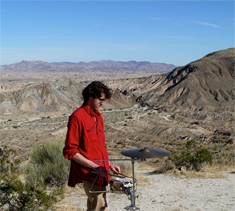

Photo by Jason Rosenberg
The Confluence of Art and Science, February 26-28, 2006 a collaboration with UC San Diego's Scripps Institute of Oceanography, Visual Arts Department, Music Department, and Alaskan composer/artist/author John Luther Adams. Sponsors: Scripps Institute of Oceanography, UCSD Music and Visual Arts Departments, Office of Graduate Studies and Research, and the Graduate Student Association.
This project begins with a performance of two works for percussion by John Luther Adams (The Mathematics of Resonant Bodies, and Strange and Sacred Noise) in the natural landscape of Anza-Borrego Desert Park in California. This performance will explore the relationships between landscape and music, and investigate how place affects musical interpretation. Following this performance, a two-day forum discussing the issues and implications of musical and artistic collaboration with the sciences. I am the performer and creator of this project. I have been responsible for all funding and organization with help from Dr. Art Miller, Scripps Inst. Of Oceanography; Steven Schick, UC, San Diego Music Department; and John Luther Adams, composer/artist/author.
The inspiration for this event begins with John Luther Adams' ideas of music and place. Refer to JLA's Winter Music and www.johnlutheradams.com. For me I am interested in discovering how place affects interpretation, both for myself and for the listener (participant). Our traditional concert infrastructure is designed for the listener to 'hear' the music, and to 'see' the music. We have lights, a stage, sound system, nice seats, and an acoustically refined space. These are fixed variables and force the listener to experience music in a very particular manner. This project focuses on music and performance as an experience, and as a process. The desert region provides a natural landscape barren of stimuli and infrastructure remitting the real experience. It has been said that JLA 'composes the North', a method which is suitable to an experience. My goal is to capture this essence, and allow the landscape to speak.
An adjunct to this idea is the concept of awareness. Not just awareness of new performance media and collaboration, but awareness of environment, and ones personal connection to environment. The workshop which follows this performance will begin to discuss the idea of awareness in both the arts and sciences. The question I plan to explore is - Can artists use their natural environment as a place, subject, canvas or something else? and if so - Could this create an awareness of the unique qualities of these environments and their worth in conservation efforts? Are we aware of how environment affects our interpretation of art? and finally - Could this strengthen with scientific collaboration and gain support for conservation of land, and interests in climate change?.
Reading List: